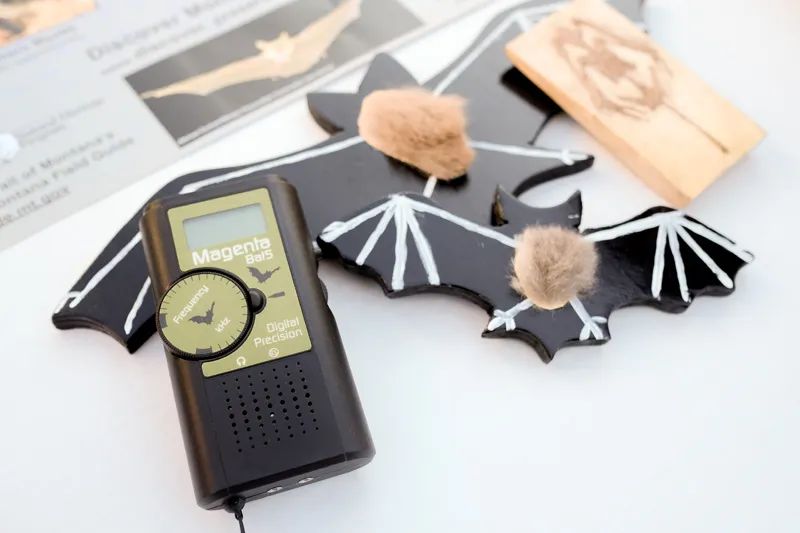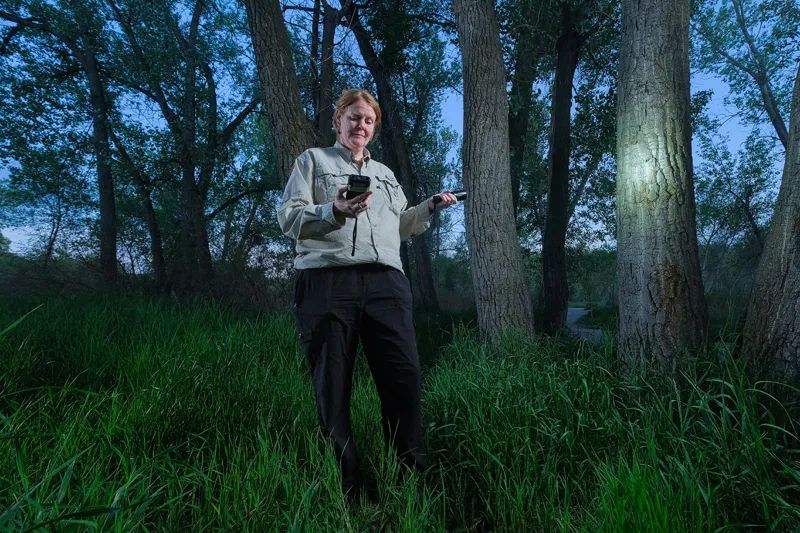
Hanging With Bats
Wildlife Biologist walks, talks & teaches to spark bat conservation
The sun was just slipping below the horizon when the parking lot at Norm’s Island started to buzz. It wasn’t insects making the noise, but the fuzzy static sounds created by a handheld meter that turns ultrasonic bat calls into something people can hear.
“It sounds like a click,” says Megan O’Reilly, a wildlife biologist with Montana Fish, Wildlife and Parks. And, she says, when people hearing that click look up quickly, chances are they’ll spot a bat flying in its telltale erratic pattern overhead.
“Most likely, we’ll see little brown bats. We’ll probably see some spotted bats,” she says. They’re just two of the 15 bat species in Montana. They’re the most common, especially in these parts.
O’Reilly and her crew — Amber Stapleton, a wildlife intern, and Jerry Krause, an FWP volunteer — were just about to take a nighttime trek around Norm’s Island on the hunt for bats. By 9 p.m., the group had reached the southern portion of the trail that overlooks the Yellowstone River, hoping to spot some. O’Reilly, armed with an iPad and a sophisticated microphone, looked at the sound waves being picked up. Even though the insects were thick, there were no signs that the bats were starting to hit the sky for dinner.
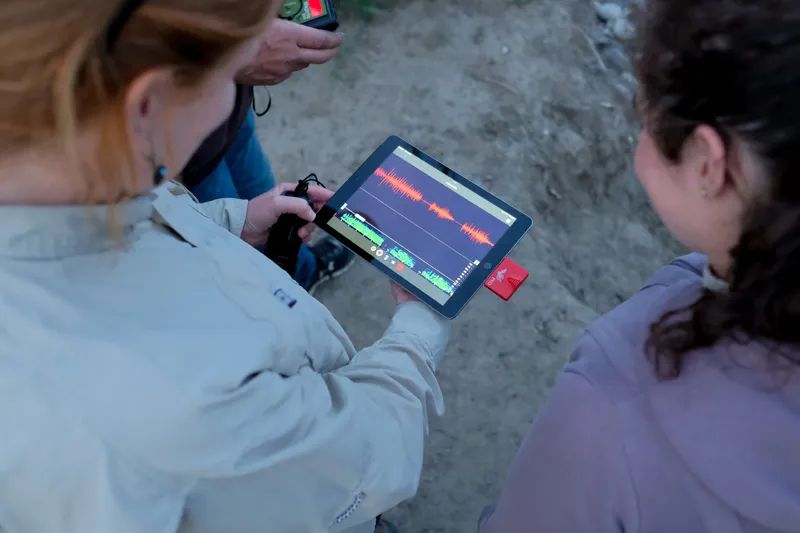
By 9:45, as the last bit of light was starting to fade, the small detector in my hand started making a whooshing click noise that’s really hard to replicate and even harder to describe.
“Is that it?” I yelled. “Yes. That’s it!” O’Reilly said as she glanced down at her iPad and saw the tiny blue crescent sound waves that bats create. “What frequency are you on?” she asked. As I was telling her that it was 29.5 kHz, our heads were on a swivel. We knew a bat was there but we didn’t see it, yet.
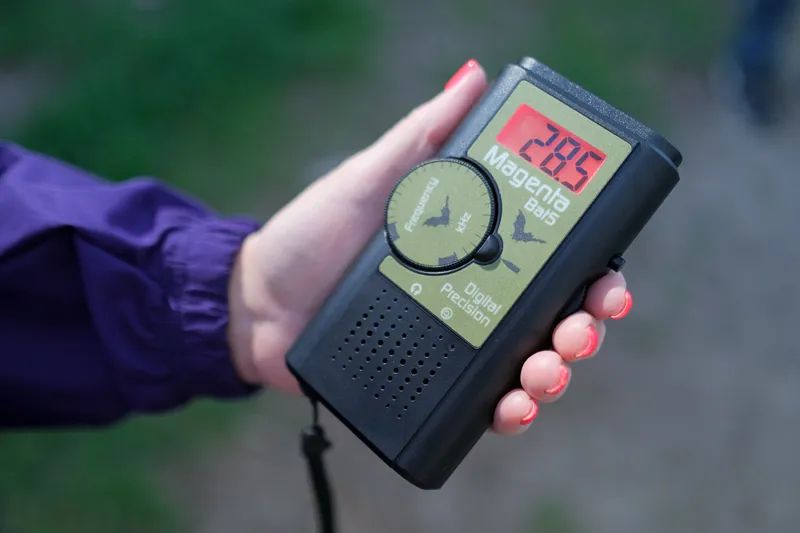
Walking along the island’s outer trail, alongside a small river channel, the clicking noise returned, and it was louder this time.
“There’s one!” one of us yelled and flying off was what’s believed to be a Little Brown Bat moving back toward the center of the island.
“It flew right over my head,” Stapleton said.
“One little brown bat, which is our most common species in Billings and in Montana, can eat 1,200 mosquitos an hour,” O’Reilly told the group, adding that all of the bats who call the state home feast only on insects.
“Do you scout the area first?” Melanie Fabrizius, one of the guests in the group, asked.
“I did here the first time,” O’Reilly answers. “One of the game wardens came with me because I didn’t want to creep around Norm’s Island at night all by myself.” She adds, “Now, I know they are here.”
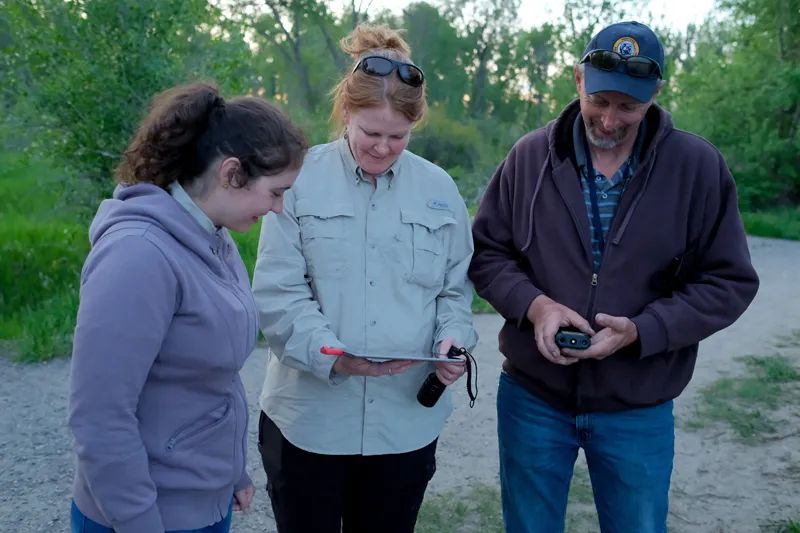
During the summer months, O’Reilly will lead groups on what she calls her Bat Walks. “I’m very passionate about bats and education,” she says. “I’ve done eight bat walks here and I’ve only had one walk where we didn’t see a bat.”
O’Reilly says she does these walks because it’s important for conservation.
“They are important critters,” O’Reilly says, pointing out that bats lose habitat every time a new subdivision is built. Wind turbines have killed off bats and pesticides have limited their prey. White Nose Syndrome, a fungus that affects hibernating bats, has also been found in Montana and has been known to kill off bats in record numbers. While it’s only been found in a little more than a half dozen counties in Montana, O’Reilly says there is sampling going on this summer to track it further.
The threat is important to study because O’Reilly says a bat’s reproduction rate is slow.
“They have one to two pups a year,” she says, adding that bats live long lives. Little brown bats can live more than 30 years. “They are slow to reproduce. If you knock out 50 to 100 bats in a colony, it is going to take a long time to get them back.”
When a female bat gets pregnant, she says, maternity colonies emerge with other pregnant bats seeking shelter. Sometimes it will be a cave. Other times, they’ll find a home in an attic. O’Reilly says because of a bat’s slow reproduction, if you find a bat in your home, “You can certainly call us at Fish, Wildlife and Parks.” That way, she says, the bat will be safe and wildlife biologists can tell you how to seal up your home to prevent bats from landing in your home again.
Education has always been at the core of O’Reilly’s decades-long career. She’s worked in Antarctica helping to keep tabs on Weddle seals. She’s worked alongside conservationists tracking lions in Western Africa. Now, she helps those in our area learn about Montana’s wildlife and, in this case, educating them about the world’s only flying mammal.
“One of my proudest moments was when I had 100 people come to a bat walk on a Friday night. One hundred people chose to do this on a Friday night,” she says. “I enjoy doing these walks because people can’t conserve something they don’t know about.”
